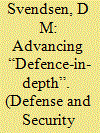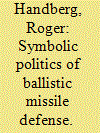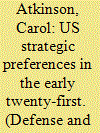|
|
|
Sort Order |
|
|
|
Items / Page
|
|
|
|
|
|
|
| Srl | Item |
| 1 |
ID:
137939


|
|
|
|
|
| Summary/Abstract |
This article aims to encourage the fostering of more systems thinking, and its greater exploitation, within the domain of contemporary intelligence. With particular focus on “micro systems thinking” and with reference to key intelligence processes, such as intelligence analysis, the utility of many systems dynamics within the intelligence context seeks to be further revealed. Through their greater collective harnessing, including up to “System of Systems” (“SoS”) dynamics, and promoting all that they can offer, more sophisticated overarching operational-to-strategic/policy “ends,” notably that of “defence-indepth,” can be viably further advanced in a sustainable manner into the future. Arguably, a much-needed transformative impact on contemporary intelligence can also be increasingly realised through comprehensively engaging in and with more systems and SoS thinking. Aiding civil protection tasks, crisis management, emergency planners, and civil contingency practitioners likewise gain.
|
|
|
|
|
|
|
|
|
|
|
|
|
|
|
|
| 2 |
ID:
137935


|
|
|
|
|
| Summary/Abstract |
The anthrax attacks of 2001 energized research directed toward reducing health onsequences from airborne contaminants by augmenting current heating ventilation and air-conditioning (HVAC) systems. Even during peacetime, interest will continue in improving HVAC components to reduce biocontaminants associated with sick building syndrome. Current HVAC design uses numerical simulation methods of ordinary differential equations to predict approximate erformance. The authors show that state-space Laplace Transform calculations actually solve the underlying differential equations and yield algebraic expressions that provide new insight. To sharpen the arguments in favor of this methodology, attention is restricted to improving existing HVAC systems to increase protection from an external release of hazardous particulates. By nearly eliminating the need for dynamical simulation, the resulting methods can be applied to far more complex HVAC designs with little additional computational effort. The new methods reduce the time required for computation by three orders of magnitude. These algebraic methods also can be extended to disparate technical problems including internal particulate release, gas masks, and designing new protective buildings.
|
|
|
|
|
|
|
|
|
|
|
|
|
|
|
|
| 3 |
ID:
137940


|
|
|
|
|
| Summary/Abstract |
This article describes the results of research into the social phenomenon of “respect” as framed by junior members of the British Army, as part of a wider study into the Values and Standards of the British Army. This research was interview based, using qualitative analysis software to detect, manage, and draw conclusions from the qualitative data recorded in those interviews. The data indicated that the primary situation in which “respect” was visualised by the participants was the unit context, and that it comprised a combination of three different strands: respect for rank or “hierarchical respect,” “professional respect” for a person’s military competence, and “personal respect” for an individual’s character, personal behaviour, and attributes. The overall respect that an individual is given arises from the combination of these three areas. “Respect” as a concept was, in the soldiers’ characterisation, something that had to be earned (except for the “given” represented by rank) and was not stable: a person’s fund of respect could go up or down in social value. Respect was also linked to trust: the more respect a person had, the more they could be trusted. Although the unit context was the primary one for discussing their framing of the concept of respect, many of the participants reported a wider dimension in which every human being deserves a basic level of respect simply for being human, and this level could not be forfeited.
|
|
|
|
|
|
|
|
|
|
|
|
|
|
|
|
| 4 |
ID:
137938


|
|
|
|
|
| Summary/Abstract |
Ballistic missile defense (BMD) politics present an interesting evolution in how the USA, especially Congress, has come to think about BMD both as operational reality and as a symbolic policy. The argument here is that BMD’s operational reality is increasingly overshadowed by its symbolic aspects. Such a status arose from rapidly changing international and domestic politics. The end result is a situation in which BMD policy in a sense floats above the question of its actual combat effectiveness. Its primary mission in part is sustaining US capacity to remain a global power and support its allies.
|
|
|
|
|
|
|
|
|
|
|
|
|
|
|
|
| 5 |
ID:
137937


|
|
|
|
|
| Summary/Abstract |
This article investigates how US national security planners have envisioned the emerging strategic environment during the early twenty-first century and evaluates how their perceptions of this strategic environment have changed during these years. This conceptual evolution can be seen in how defense planners define threats, identify defense priorities, and design security strategies. Five key strategic planning documents serve as the basis for this analysis and illustrate significant shifts in how the US government has envisioned its own security requirements as well as the context within which its strategic vision will need to be realized. These planning documents are: (1) Joint Vision 2020, (2) the Bush Administration’s 2002 National Security Strategy of the United States, (3) the Obama Administration’s 2010 National Security Strategy, (4) US Strategic Defense Guidance entitled Sustaining US Global Leadership: Priorities for 21st Century Defense, and (5) the US Chairman of the Joint Chiefs of Staff’s Capstone Concept for Joint Operations: Joint Force 2020.
|
|
|
|
|
|
|
|
|
|
|
|
|
|
|
|
|
|
|
|
|